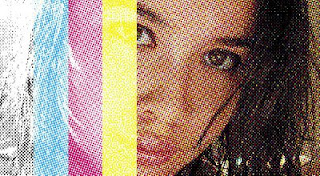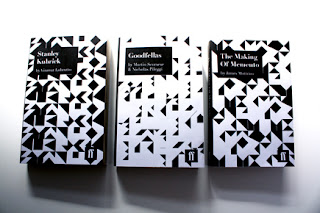By using different processes you can effectively produce different finishes to the chosen stock, thinking appropriately about the final outcome of your design will allow a defined overall look to a piece of design.
The three main processes of rotary print are:-
- Offset Lithography
- Rotogravure
- Flexography
OFFSET LITHOGRAPHY (LITHO)
This process of printing involves an extremely high volume process to produce consistent results in a fairly short space of time. Sheet-fed Litho involves using the CMYK four colour process, each plate containing the appropriate colour. Web litho uses a continuous roll to allow an increase in printing volume effectively producing larger amounts of print.
The video below demonstrates to motion of the Litho print production method and what can ultimately be achieved by using this process. Each machine typically involves four main towers, each with one colour assigned to systematically apply the ink to paper.
HALFTONES
This process is used to create an illusion of the original image by replicating the photographic tones that are used in print. By using this method, the dots can be built up to create a full colour CMYK finished image, normally appropriated to a photograph or full colour detailed image.
Greyscale - Single coarse halfton screen.
Duotone - Double halftone screen. Normally using black with either a spot colour.
Four-colour Image - Four screens using full CMYK colour.
Four-colour Black - Four screens using full CMYK colour to create a richer Monotone colour.
SCREEN ANGLES
Screen angles determine the amount of interference that can be generated by the coloured dots, in order to produce a more effective outcome to print. The standard angles for the CMYK process colours are ) black 45 degrees, magenta 75 degrees, yellow 90 degrees and cyan 105 degrees)
This can allow further colours to be added without any difficulty in determining the way the process can be printed. More colours will lead to a greater cost but can also create much greater depth in a piece of design work.
MOIRÉ
Although the most effective way to produce an image using screen angles is to have them apart from each other, you can alternatively create moiré patterns by having interference of over layered referred to as a basket-weave.
----------------------------------------------------------------------------------------------------------------------------------
CTP (Computer to Plate)
This process is based on creating printing plate directly from an electronic file as apposed to using a formed plate from printing film. By doing this you remove one less process from the production line, ultimately creating a much more detailed, higher resolution image. The environment surrounding the process is completely sterile which then reduces dust and any damages that could effect the quality of print finish.
DOT GAIN
A natural process that involves enlarging the ink dots to create a more absorbent print. Using a coated stock results in a much sharper image reproduction.
SCREEN RULING
Using different coarse values to determine the clarity of an image produced can have a range of different qualities. The most common values are 60 (coarse) 133 (general purpose) and 175 (high quality) by correctly selecting the appropriate technique, you can create less saturated images depending on the quality of stock and values.
LOW-VALUE TINTS
By having the ability to produce high resolution print finishes, CTP can effectively create finer tints that are much finer than most other lithography processes.
REVERSING OUT
ROTOGRAVURE
This process of print is similar to lithography in terms of the function that it works in. There is a copper plate that has the image for print engraved, this results in increased durability for a longer period of time. Obviously the cost of print grows but if you are producing batches of 10000 prints or more, constantly then this is the ideal process to be used.
Typical pieces of design work that may be used involve flooring, brochures and magazines. Additional operations can be included during this process, such as saddle stitching. Allowing the brochure to be bound along the production line with one swift motion.
Rotogravure
Rotogravure (gravure for short) is a type of intaglio printing process, in that it involves engraving the image onto an image carrier. In gravure printing, the image is engraved onto a copper cylinder because, like offset and flexography, it uses arotary printing press. The vast majority of gravure presses print on reels of paper, rather than sheets of paper. (Sheetfed gravure is a small, specialty market.) Rotary gravure presses are the fastest and widest presses in operation, printing everything from narrow labels to 12-feet-wide rolls of vinyl flooring. Additional operations may be in-line with a gravure press, such as saddle stitching facilities for magazine/brochure work.
Gravure cylinders nowadays are typically engraved digitally by a diamond tipped or laser etching machine. On the gravure cylinder, the engraved image is composed of small recessed cells (or 'dots') that act as tiny wells. Their depth and size control the amount of ink that gets transferred to the substrate (paper or other material, such as plastic or foil) via a process of pressure, osmosis, and electrostatic pull. (A patented process called "Electrostatic Assist" is sometimes used to enhance ink transfer.)
A rotogravure printing press has one printing unit for each color, typically CMYK or cyan, magenta, yellow and key (printing terminology for black). The number of units vary depending on what colors are required to produce the final image. There are five basic components in each color unit: an engraved cylinder (whose circumference can change according to the layout of the job), an ink fountain, a doctor blade, an impression roller, and a dryer. While the press is in operation, the engraved cylinder is partially immersed in the ink fountain, filling the recessed cells. As the cylinder rotates, it draws ink out of the fountain with it. Acting as a squeegee, the doctor blade scrapes the cylinder before it makes contact with the paper, removing ink from the non-printing (non-recessed) areas. Next, the paper gets sandwiched between the impression roller and the gravure cylinder. This is where the ink gets transferred from the recessed cells to the paper. The purpose of the impression roller is to apply force, pressing the paper onto the gravure cylinder, ensuring even and maximum coverage of the ink. Then the paper goes through a dryer because it must be completely dry before going through the next color unit and absorbing another coat of ink.
Because gravure is capable of transferring more ink to the paper than other printing processes, gravure is noted for its remarkable density range (light to shadow) and hence is a process of choice for fine art and photography reproduction, though not typically as clean an image as that of sheet fed litho or web offset litho. Gravure is widely used for long-run magazine printing in excess of 1 million copies. Gravure's major quality shortcoming is that all images, including type and "solids," are actually printed as dots, and the screen pattern of these dots is readily visible to the naked eye. Examples of gravure work in the United States are typically long-run magazines, mail order catalogs, consumer packaging, and Sunday newspaper ad inserts.
Other application area of gravure printing is in the flexible packaging sector. A wide range of substrates such as Polyethylene, Polypropylene, Polyester, BOPP etc.. can be printed in the gravure press.
A rotogravure printing press has one printing unit for each color, typically CMYK or cyan, magenta, yellow and key (printing terminology for black). The number of units vary depending on what colors are required to produce the final image. There are five basic components in each color unit: an engraved cylinder (whose circumference can change according to the layout of the job), an ink fountain, a doctor blade, an impression roller, and a dryer. While the press is in operation, the engraved cylinder is partially immersed in the ink fountain, filling the recessed cells. As the cylinder rotates, it draws ink out of the fountain with it. Acting as a squeegee, the doctor blade scrapes the cylinder before it makes contact with the paper, removing ink from the non-printing (non-recessed) areas. Next, the paper gets sandwiched between the impression roller and the gravure cylinder. This is where the ink gets transferred from the recessed cells to the paper. The purpose of the impression roller is to apply force, pressing the paper onto the gravure cylinder, ensuring even and maximum coverage of the ink. Then the paper goes through a dryer because it must be completely dry before going through the next color unit and absorbing another coat of ink.
Because gravure is capable of transferring more ink to the paper than other printing processes, gravure is noted for its remarkable density range (light to shadow) and hence is a process of choice for fine art and photography reproduction, though not typically as clean an image as that of sheet fed litho or web offset litho. Gravure is widely used for long-run magazine printing in excess of 1 million copies. Gravure's major quality shortcoming is that all images, including type and "solids," are actually printed as dots, and the screen pattern of these dots is readily visible to the naked eye. Examples of gravure work in the United States are typically long-run magazines, mail order catalogs, consumer packaging, and Sunday newspaper ad inserts.
Other application area of gravure printing is in the flexible packaging sector. A wide range of substrates such as Polyethylene, Polypropylene, Polyester, BOPP etc.. can be printed in the gravure press.
FLEXOGRAPHY
Commonly used for more everyday essential pieces of design work, ranging from labels, food packaging and general throw away packets. Mass produced on a large scale in order to maximise the potential profit growth from a product. it has the basic similarities of other rotary print processes, where a plate is wrapped around a cylinder forming the printing structure for the print to work. Unlike gravure or litho, the plate is made from a synthetic rubber material or photopolymer. This again in turns reduces the price of printing as there is no need to use expensive metals to create a plate for print.
This is a magazine solely created to show the process of flexography and any new developments that can be achieved throughout. It clearly identifies what is currently new on the market and what you can achieve successfully by keeping up to date in the printing world. Pretty interesting read really.
http://www.flexography.org/index.php










No comments:
Post a Comment